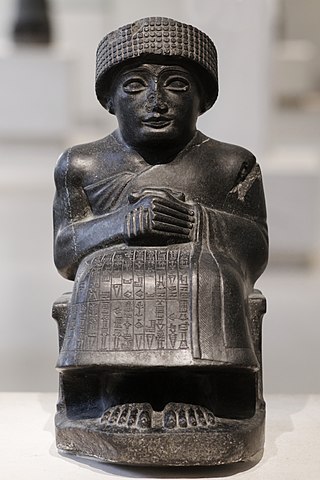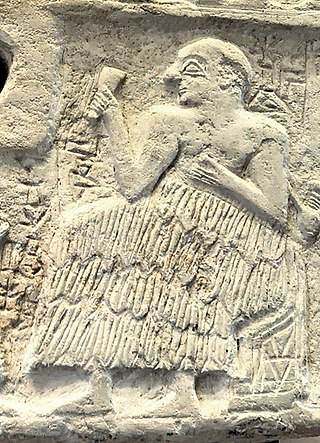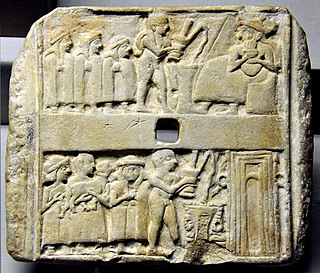
The Hurrians were a people who inhabited the Ancient Near East during the Bronze Age. They spoke the Hurrian language, and lived throughout northern Syria, upper Mesopotamia and southeastern Anatolia.

Nergal was a Mesopotamian god worshiped through all periods of Mesopotamian history, from Early Dynastic to Neo-Babylonian times, with a few attestations indicating that his cult survived into the period of Achaemenid domination. He was primarily associated with war, death, and disease, and has been described as the "god of inflicted death". He reigned over Kur, the Mesopotamian underworld, depending on the myth either on behalf of his parents Enlil and Ninlil, or in later periods as a result of his marriage with the goddess Ereshkigal. Originally either Mammitum, a goddess possibly connected to frost, or Laṣ, sometimes assumed to be a minor medicine goddess, were regarded as his wife, though other traditions existed, too.

Gudea (Sumerian: 𒅗𒌤𒀀, Gu3-de2-a) was a ruler (ensi) of the state of Lagash in Southern Mesopotamia, who ruled c. 2080–2060 BC (short chronology) or 2144-2124 BC (middle chronology). He probably did not come from the city, but had married Ninalla, daughter of the ruler Ur-Baba (2164–2144 BC) of Lagash, thus gaining entrance to the royal house of Lagash. He was succeeded by his son Ur-Ningirsu. Gudea ruled at a time when the center of Sumer was ruled by the Gutian dynasty, and when Ishtup-Ilum ruled to the north in Mari. Under Gudea, Lagash had a golden age, and seemed to enjoy a high level of independence from the Gutians.

Urkesh, also transliterated Urkish, is a tell, or settlement mound, located in the foothills of the Taurus Mountains in Al-Hasakah Governorate, northeastern Syria. It was founded during the fourth millennium BC, possibly by the Hurrians, on a site which appears to have been inhabited previously for a few centuries. The city god of Urkesh was Kumarbi, father of Teshup.

Ur-Nanshe also Ur-Nina, was the first king of the First Dynasty of Lagash in the Sumerian Early Dynastic Period III. He is known through inscriptions to have commissioned many buildings projects, including canals and temples, in the state of Lagash, and defending Lagash from its rival state Umma. He was probably not from royal lineage, being the son of Gunidu who was recorded without an accompanying royal title. He was the father of Akurgal, who succeeded him, and grandfather of Eanatum. Eanatum expanded the kingdom of Lagash by defeating Umma as illustrated in the Stele of the Vultures and continue building and renovation of Ur-Nanshe's original buildings.

Naram-Sin, also transcribed Narām-Sîn or Naram-Suen, was a ruler of the Akkadian Empire, who reigned c. 2254–2218 BC, and was the third successor and grandson of King Sargon of Akkad. Under Naram-Sin the empire reached its maximum strength. He was the first Mesopotamian king known to have claimed divinity for himself, taking the title "God of Akkad", and the first to claim the title "King of the Four Quarters". He became the patron city god of Akkade as Enlil was in Nippur.

Shulgi of Ur was the second king of the Third Dynasty of Ur. He reigned for 48 years, from c. 2094 – c. 2046 BC or possibly c. 2030 – 1982 BC. His accomplishments include the completion of construction of the Great Ziggurat of Ur, begun by his father Ur-Nammu. On his inscriptions, he took the titles "King of Ur", "King of Sumer and Akkad" and "King of the four corners of the universe". He used the symbol for divinity before his name, marking his apotheosis, from the 23rd year of his reign.

Used by Sumerians and other Mesopotamian cultures beginning in the third millennium BC, clay nails, also referred to as dedication or foundation pegs, cones, or nails, were cone-shaped nails made of clay, inscribed with cuneiform, baked, and stuck into the mudbrick walls to serve as evidence that the temple or building was the divine property of the god to whom it was dedicated. Versions were also made of metal, including castings with figurative designs, such as the Hurrian foundation pegs.

Linear Elamite was a writing system used in Elam during the Bronze Age between c. 2300–1850 BCE, and known mainly from a few extant monumental inscriptions. It was used contemporaneously with Elamite cuneiform and records the Elamite language. The French archaeologist François Desset and his colleagues have argued that it is the oldest known purely phonographic writing system, although others, such as the linguist Michael Mäder, have argued that it is partly logographic.

Girsu was a city of ancient Sumer, situated some 25 km (16 mi) northwest of Lagash, at the site of modern Tell Telloh, Dhi Qar Governorate, Iraq.
The Dynasty of Isin refers to the final ruling dynasty listed on the Sumerian King List (SKL). The list of the Kings Isin with the length of their reigns, also appears on a cuneiform document listing the kings of Ur and Isin, the List of Reigns of Kings of Ur and Isin.

Entemena, also called Enmetena, lived circa 2400 BC, was a son of En-anna-tum I, and he reestablished Lagash as a power in Sumer. He defeated Il, king of Umma, in a territorial conflict through an alliance with Lugal-kinishe-dudu of Uruk, successor to Enshakushanna, who is in the king list. The tutelary deity Shul-utula was his personal deity. His reign lasted at least 19 years.

Sumerian religion was the religion practiced by the people of Sumer, the first literate civilization of ancient Mesopotamia. The Sumerians regarded their divinities as responsible for all matters pertaining to the natural and social orders.

Tish-atal was endan of Urkesh during the Third Dynasty of Ur. He was one of the earliest known Hurrian rulers, but the archaeological record is fragmentary for this period, and no precise date can be ascribed to his reign.

Ur-Baba or Ur-Bau (Sumerian: 𒌨𒀭𒁀𒌑ur-Dba.ba6 or ur-Dba.U2, servant of the goddess Bau) was ensi of Lagash from 2093 BC – 2080 BC (short chronology) or 2157 BC – 2144 BC (middle chronology), roughly contemporaneous with the last king of Akkad, Shu-turul. In one of his inscriptions, he refers to himself as a child of the god Ninagal (Sumerian: 𒀭𒎏𒀉𒃲).

Foundation figures were ritualistic works of art from the Early Dynastic period that were used in the construction of ancient Mesopotamian temples. Foundation pegs first appeared in ancient Sumer around the third millennium BCE. Stylized as anthropomorphic nails, foundation figures were symbolically used to mark the grounds of a temple. These nails/pegs were either hammered around the foundation of the temple, along with an inscribed tablet, or they were buried in clay boxes under the foundation of the temple. Typically, the pegs were created to represent either the deity that the temple was honoring, or the king that orchestrated the construction of the temple. Many of the pegs discovered stand about a foot tall and show a clear attention to detail. It is believed that foundation figures were used for solely ritualistic purposes. This is because they were not meant to be seen by the public, yet still show a high level of detail and aesthetic thought.

Ur-Ningirsu also Ur-Ningirsu II in contrast with the earlier Ur-Ningirsu I, was a Sumerian ruler (ensi) of the state of Lagash in Southern Mesopotamia who ruled c. 2110 BC. He was the son of the previous ruler of Lagash named Gudea.

A'annepada was a king of the First Dynasty of Ur, c. 2600 BCE. He was a son of Mesannepada. It is thought that his tomb may be tomb PG 580 in the Royal Cemetery at Ur.

Lugal-kisalsi, also Lugaltarsi was a King of Uruk and Ur who lived towards the end of the 25th century BCE, succeeding his father Lugal-kinishe-dudu, according to contemporary inscriptions, although he does not appear in the Sumerian King List. In one of his inscriptions, he appears as "Lugalkisalsi, the first-born son of Lugalkigenedudu, king of Uruk and Ur".

Ishtup-Ilum, also Ishtup-El was a ruler of the city of Mari, one of the military governors known as Shakkanakku in northern Mesopotamia, after the fall of the Akkadian Empire. He was probably contemporary with the Second Dynasty of Lagash, around the time of Gudea. He was the son of Ishma-Dagan and brother of Nûr-Mêr, both Shakkanakkus of Mari before him, and, according to the dynastic lists, he ruled after them for a period of 11 years.




















